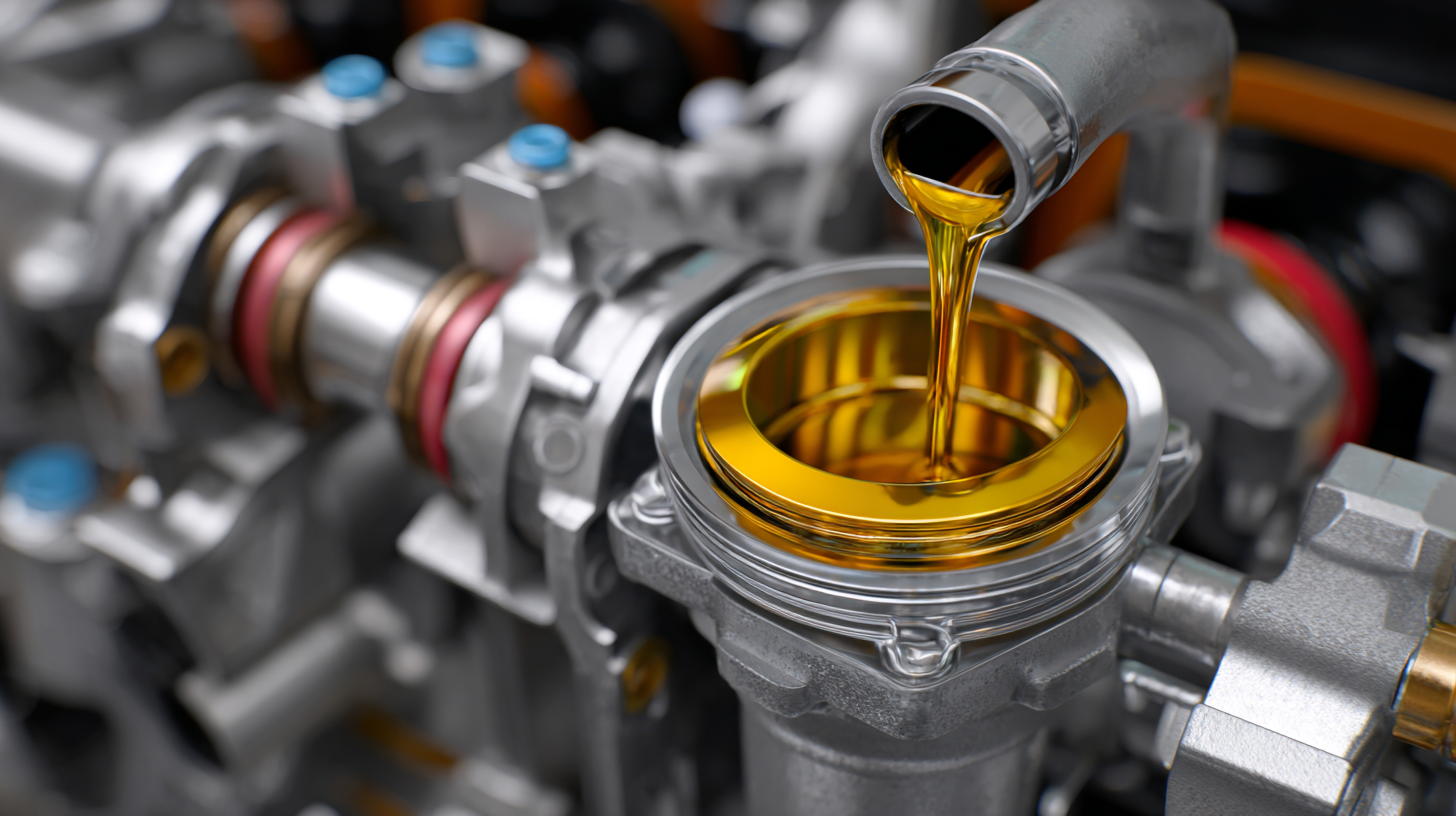Discover the Essential Benefits of Choosing the Right Lubricant for Your Needs
Choosing the right lubricant is crucial for optimizing performance and ensuring the longevity of machinery and equipment across various industries. According to a report by Markets and Markets, the global lubricant market is expected to reach $163.5 billion by 2025, driven by increasing demand for industrial and automotive lubricants. Proper lubrication can reduce friction and wear, improve energy efficiency, and prolong the operational life of components. Furthermore, a study by the American Society of Mechanical Engineers (ASME) indicates that effective lubrication can lead to energy savings of up to 10% in industrial operations.

By understanding the essential benefits of selecting the appropriate lubricant tailored to specific applications, businesses can enhance operational efficiency while minimizing costs and downtime.
Understanding the Different Types of Lubricants Available Today
When selecting the right lubricant for your specific needs, understanding the various types available is crucial.
Lubricants can be classified into several categories, including
oil-based, grease-based, and synthetic options. Each type serves distinct functions and is formulated for different applications,
ranging from automotive to industrial machinery.
Oil-based lubricants typically excel in reducing friction in high-temperature environments,
while grease-based products provide superior staying power in applications requiring
longer-lasting lubrication.
The global automotive lubricant market is projected to witness steady growth, with estimates suggesting it will expand from
$71.42 billion in 2024 to
$80.35 billion by 2032. This growth underscores the importance of selecting the right lubricant
to enhance performance and efficiency in vehicles. Additionally, advancements in technology are resulting in more effective formulations that
cater to emerging needs, including environmental considerations and decarbonization efforts
in sectors like maritime shipping. As industries evolve,
the choice of lubricant becomes not just a matter of preference,
but a critical decision for operational success and sustainability.
Key Factors to Consider When Choosing the Right Lubricant
Choosing the right lubricant is crucial for ensuring optimal performance and longevity of machinery and equipment. One of the key factors to consider is the viscosity of the lubricant, which significantly affects the efficiency of operation. According to a report by the American Society of Mechanical Engineers, using lubricants with inappropriate viscosity can lead to a 10-15% increase in friction, resulting in greater energy consumption and wear. Therefore, selecting a lubricant that matches the operating temperature and the specific application is essential for reducing costs and improving equipment reliability.
Another important consideration is the type of base oil used in the lubricant. Synthetic oils, for example, offer superior stability and temperature resistance compared to conventional mineral oils. A study published in the Journal of Tribology highlighted that synthetic lubricants could extend service life by up to 50% under extreme conditions. Additionally, incorporating additives such as anti-wear agents and corrosion inhibitors can enhance the lubricant’s performance. Understanding the specific requirements of your machinery can help in making informed decisions that lead to not only improved efficiency but also reduced maintenance costs.
Top 5 Benefits of Using the Right Lubricant for Your Applications
 Choosing the right lubricant for your applications can significantly enhance performance and longevity. One of the primary benefits is improved equipment efficiency. Proper lubrication reduces friction between moving parts, leading to smoother operation and lower energy consumption. This not only extends the life of machinery but also helps in achieving optimal performance, as components can work together more effectively.
Choosing the right lubricant for your applications can significantly enhance performance and longevity. One of the primary benefits is improved equipment efficiency. Proper lubrication reduces friction between moving parts, leading to smoother operation and lower energy consumption. This not only extends the life of machinery but also helps in achieving optimal performance, as components can work together more effectively.
Another crucial advantage is the reduction of wear and tear. High-quality lubricants form a protective layer that minimizes direct metal-to-metal contact, which effectively decreases the risk of damage over time. This is especially vital in high-stress environments, where the right lubricant can prevent costly downtime and repairs. Additionally, certain lubricants can also enhance resistance to contaminants and extreme temperatures, ensuring that your equipment operates under a wider range of conditions without compromising performance.
Furthermore, selecting the right lubricant can lead to significant cost savings. By enhancing the efficiency and lifespan of machines, businesses can reduce maintenance costs and avoid premature equipment failure. Utilizing the appropriate lubricant fosters a more reliable operation and contributes to better overall productivity, making it a smart investment for any organization.
How Proper Lubrication Can Enhance Equipment Longevity
Proper lubrication is crucial for enhancing the longevity of equipment across various industries. When machines operate, friction between moving parts generates heat, leading to wear and tear. However, using the right lubricant can significantly reduce this friction. High-quality lubricants form a protective film between surfaces, minimizing contact and preventing premature damage. By selecting lubricants that match the specific requirements of the machinery, such as viscosity and temperature resistance, operators can ensure optimal performance and longer lifespans for their equipment.
Moreover, regular maintenance that includes proper lubrication practices helps in identifying potential issues early on. For instance, performing routine checks on lubricant levels and quality can reveal signs of wear or contamination, allowing for swift action to be taken before significant damage occurs. This proactive approach not only saves on repair costs but also maximizes uptime, ensuring that operations run smoothly. In this way, investing time and resources in the right lubricant fosters a more sustainable and efficient work environment.
Choosing Eco-friendly Lubricants: Benefits for Sustainability and Performance
When it comes to choosing lubricants, eco-friendly options are gaining traction due to their dual advantage of sustainability and performance. The International Organization for Standards (ISO) has reported that using biodegradable lubricants can significantly reduce environmental pollution, with studies showing that up to 90% of these products can be broken down by microorganisms within a year. This acceleration in decomposition not only mitigates the impact on local ecosystems but also aligns with growing regulations advocating for greener alternatives.
 Moreover, eco-friendly lubricants often outperform their conventional counterparts in certain applications. According to a study published by the American Society of Mechanical Engineers (ASME), products containing plant-based oils demonstrated superior lubrication properties, resulting in reduced wear and tear on machinery. Specifically, these lubricants can lower friction by up to 25% compared to standard petroleum-based options, leading to prolonged equipment life and decreased operational costs. This combination of environmental stewardship and enhanced performance makes eco-friendly lubricants a prudent choice for industries looking to innovate responsibly while maintaining efficiency.
Moreover, eco-friendly lubricants often outperform their conventional counterparts in certain applications. According to a study published by the American Society of Mechanical Engineers (ASME), products containing plant-based oils demonstrated superior lubrication properties, resulting in reduced wear and tear on machinery. Specifically, these lubricants can lower friction by up to 25% compared to standard petroleum-based options, leading to prolonged equipment life and decreased operational costs. This combination of environmental stewardship and enhanced performance makes eco-friendly lubricants a prudent choice for industries looking to innovate responsibly while maintaining efficiency.
Related Posts
-

7 Essential Tips for Choosing the Right Lubricant to Enhance Machinery Efficiency
-

Essential Lubricant Maintenance Checklist for Optimal Machinery Performance
-

Addressing Safety Concerns: Common Problems with Sex Swings and How to Resolve Them
-

5 Unique Ways to Enhance Your Experience with Pocket Pussy
-

Innovative Uses for Finger Vibrators to Enhance Your Sensory Experience
-

Essential Checklist for Selecting the Right Bullet Vibrator for Your Production Needs
